MARIANI’S
Virtual Gourmet
February 8, 2015
NEWSLETTER
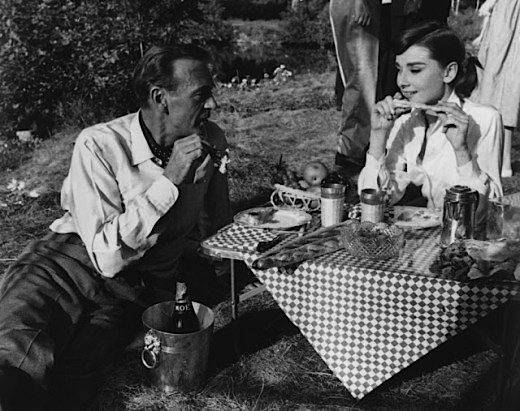
Gary
Cooper and Audrey Hepburn in "Love in the
Afternoon" (1957)
HAPPY
VALENTINE'S DAY!
♥︎
WAITING FOR GIGOT
By "Emmanuel Râclette"
NEW YORK CORNER
THE MODERN
By John Mariani
NOTES FROM THE WINE CELLAR
COLUMBIA WINERY GOES PROGRESSIVE
AT A PRICE EASY TO LOVE
By John Mariani
♥︎
WAITING FOR GIGOT
By Leumas Râclette
(Nom de Plume for John Mariani, with apologies to Samuel Beckett)
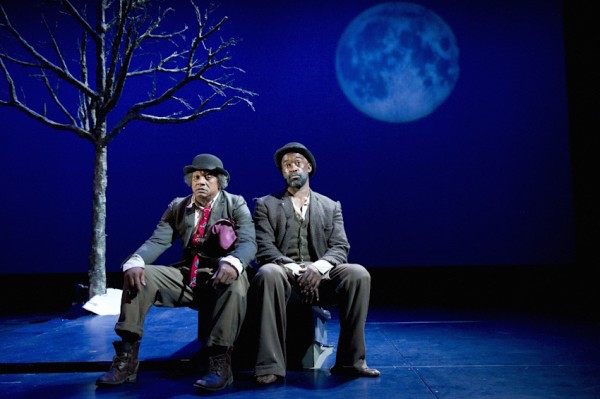
ACT ONE.
Scene One: A completely bare set, save for a
coat rack and, on the rear wall, a neon sign
reading “NO EXIT.” Two shabbily dressed
men—one, Tarragon, apparently once fat, now with
his flesh sagging; the other, Ghee-Ghee, as thin
as the coat rack; both wearing derby hats—stand
center stage, their arms at their sides.
Tarragon:
Well, nothing to be done.
Ghee-Ghee: I’m
beginning to come round to that opinion.
Tarragon:
We just have to wait.
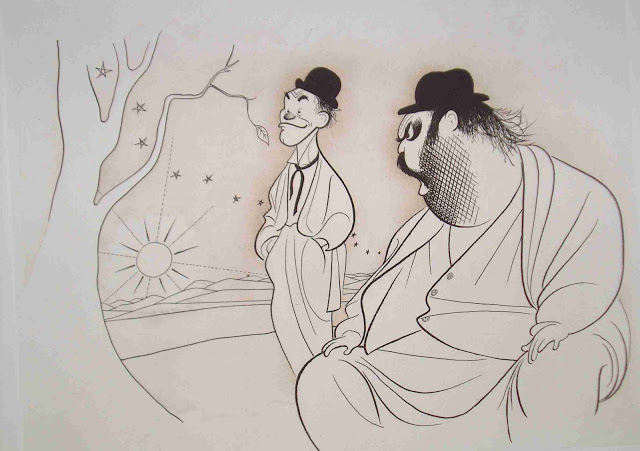 Ghee-Ghee: For
what?
Ghee-Ghee: For
what?
Tarragon:
For Gigot. [Ghee-Ghee
groans].
Ghee-Ghee:
I am so hungry.
Tarragon:
That’s why we are here. To sit down and have a
good meal.
Ghee-Ghee:
But there’s no one here. Not now. Not yesterday.
Maybe Gigot will never come.
Tarragon:
Didn’t you eat yesterday?
Ghee-Ghee: I don't remember.
Tarragon:
Well, if you don’t remember, how can you be so
sure you are hungry?
Ghee-Ghee:
I am always hungry. Isn't that why we came here?
Tarragon:
We came because I heard Gigot is un maître
cuisinier!
Ghee-Ghee: What does that mean?
Tarragon:
I wanted to but I stopped reading the book because
I owned no spoons at the time. Otherwise
I might have made myself into a great maître
cuisinier!
Gigot would become my friend and we would
eat and drink together all the time!
Ghee-Ghee:
So you’ve met Gigot?
Tarragon:
No, that is why we are waiting for him. You are so
ill-bred.
Tarragon:
Wait, I have a carrot.
Ghee-Ghee: [Taking the limp carrot] It's a
turnip.
Tarragon: No, you ate the turnip
yesterday. How's the carrot?
Ghee-Ghee:
It's a carrot. [He pauses as he eats the carrot]
Well? What do we do?
Tarragon:
Don't let's do anything. It's safer.
Ghee-Ghee:
Let's wait and see what he says.
Tarragon:
Good idea.
Ghee-Ghee: Let's wait till we
know exactly how we stand.
Tarragon:
I'm curious to hear what he has to offer. Then
we'll take it or leave it.
Ghee-Ghee:
What exactly did we ask him for?
Tarragon:
I can't remember. [He pauses and shrugs] We can
leave if you want to.
Ghee-Ghee:
But then we might never eat.
Tarragon:
Then we will stay. He must come eventually.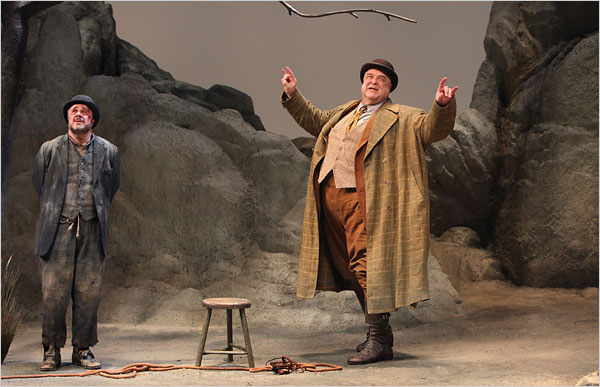
Ghee-Ghee:
Who?
Tarragon:
Gigot, you moron! [Ghee-Ghee
moans].
Ghee-Ghee: How long have we been together all the time now?
Tarragon:
I don't know. Fifty years maybe.
Ghee-Ghee:
Do you remember the day I threw myself into the
Rhône?
Tarragon: We
were grape harvesting.
Ghee-Ghee:
You fished me out.
Tarragon: That's all dead and buried.
Ghee-Ghee:
My clothes dried in the sun.
Tarragon:
There's no good harking back on that.
Ghee-Ghee:
Why don't we go to sleep?
Tarragon:
How can we eat if we go to sleep? And what if
Gigot comes while we’re asleep? He
would be furious.
Ghee-Ghee: But we
could have breakfast.
Ghee-Ghee:
Yes, that is
a good plan! I will dream of bread and butter!
Irish butter and scones! [He
immediately drops off to sleep, followed, a few
moments later, by Tarragon. The
stage slowly goes dark.]
Act
Two
Tarragon:
Ah, nothing like a good night’s sleep to improve
the appetite!
Ghee-Ghee:
Breakfast then!
Ghee-Ghee:
Let’s order everything on the menu!
Tarragon:
We can’t.
Ghee-Ghee:
Why not?
Tarragon: We have
to wait.
Ghee-Ghee:
For whom?
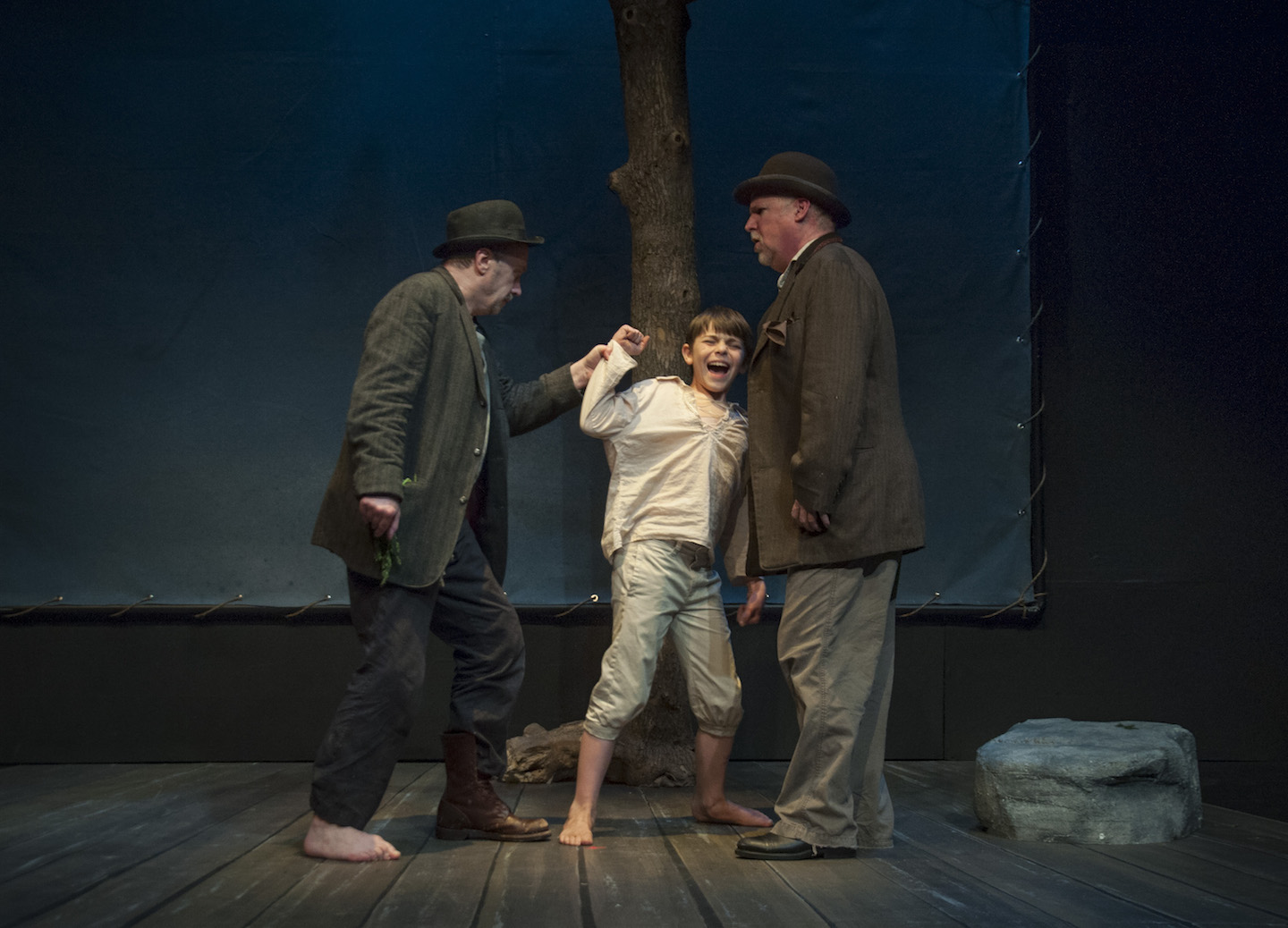 Tarragon: For
Gigot. [Ghee-Ghee
moans.]
Wait, do you see that boy over there? [The two men
huddle together.]
Tarragon: For
Gigot. [Ghee-Ghee
moans.]
Wait, do you see that boy over there? [The two men
huddle together.]
[Tarragon
flexes his arms, adjusts his hat, and, not
moving, asks, sheepishly:] Boy, who are you?
Boy:
Gigot sent me, sir.
Tarragon:
Ah! Capital! Then soon we dine! [Ghee-Ghee
claps his hands together.] Boy,
has Gigot arrived?
Boy: No,
sir, but he told me to say he will not be coming
today.
Tarragon:
But. . . will he come tomorrow?
Boy: I don’t
know, sir.
Tarragon:
Will you see him today?
Boy:
I don't know, sir.
Tarragon:
Well, please please
tell him—if you do see
him—we have been waiting here for a long time and
are very hungry.
Tarragon:
Ah! Well, that is
promising!
Ghee-Ghee: Why? He said
he didn’t know if –
Tarragon:
Fool!
Why would Gigot send the boy to tell us he
wouldn’t be coming today if he didn’t know we were
waiting for him?
Ghee-Ghee:
But I’m still hungry.
Tarragon
[brightening,
slapping his thighs]: Then I say we go!
Ghee-Ghee
[emboldened]:
Yes, let’s go! [The two of
them move towards the NO EXIT sign.]
Tarragon:
Look at that. We can’t leave.
Ghee-Ghee: Why
not?
Tarragon:
There is no
exit.
Ghee-Ghee
[sighing]:
Well. . . let’s make the best of it.
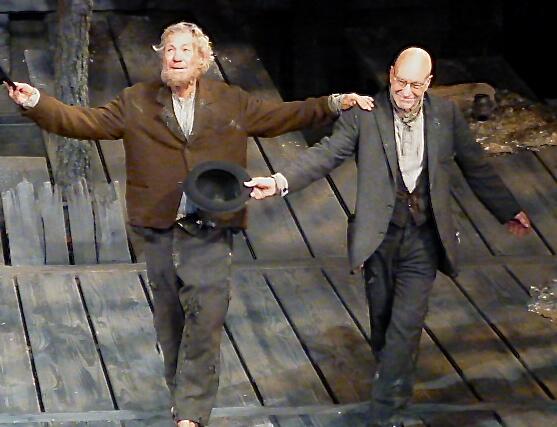
Ghee-Ghee:
Who?
Tarragon
[very
quietly]: Gigot. [Ghee-Ghee
moans.]
Ha! It will do me good to lose a little
weight. So we stay?
Ghee-Ghee: Nothing
to be done.
Tarragon: No use
struggling.
[The two men
slump and do not move. The stage slowly darkens.
Only the NO EXIT sign still glows in the
darkness.]
♥︎
By John Mariani
THE MODERN
9 West 53rd Street (near Fifth Avenue)
212-333-1220
themodernnyc.com
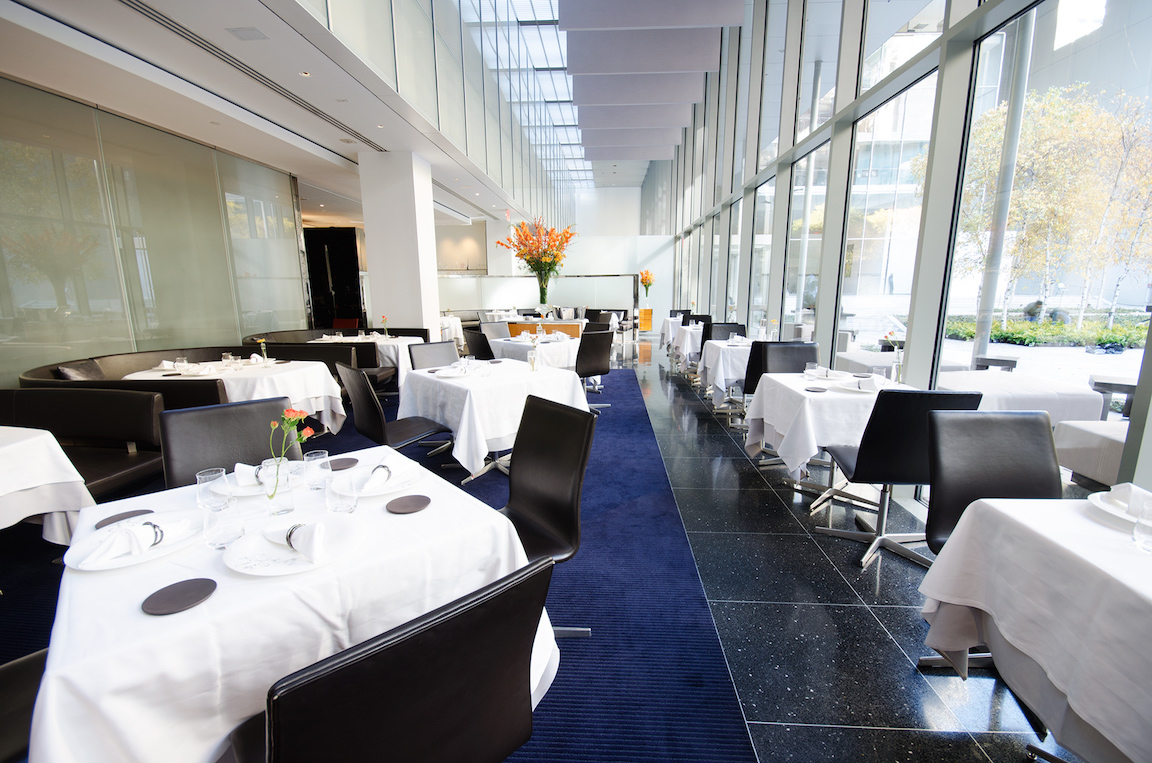 Back
in 2005 when The Modern opened
adjacent to the newly designed Museum of Modern
Art, I named it the Best New
Restaurant of the Year. Ten
years ago I described The Modern as
restaurateur Danny Meyer's masterpiece, with a
glass-rich décor by Peter Bentel,
a bar dining area packed from lunch through
dinner, and a main dining room (left) so
distinctive that it will endure as a classic of
New York sophistication and
urbanism, overlooking, as it does, the Museum's
glorious sculpture garden. Now,
after a visit last week, I can say that, if The
Modern had opened in 2015, I might
well award it the same honor
today.
Back
in 2005 when The Modern opened
adjacent to the newly designed Museum of Modern
Art, I named it the Best New
Restaurant of the Year. Ten
years ago I described The Modern as
restaurateur Danny Meyer's masterpiece, with a
glass-rich décor by Peter Bentel,
a bar dining area packed from lunch through
dinner, and a main dining room (left) so
distinctive that it will endure as a classic of
New York sophistication and
urbanism, overlooking, as it does, the Museum's
glorious sculpture garden. Now,
after a visit last week, I can say that, if The
Modern had opened in 2015, I might
well award it the same honor
today.
The
restaurant has worn those ten years well. Last
week both dining rooms were
packed, and I, in the main section, was again
amazed at the striking beauty of
it all, with its huge flower displays (which must
cost a small fortune), the
fine linens and stemware, the leather banquettes
that you slide smoothly
across, and a wait staff, now under manager Simon
King, formerly of The Fat
Duck in England, that proves that dining at this
level demands a specialized
style of highly informed servers whose respect for
the guest is paramount.
Lighting is soft and complementary to
everyone, though it seems darker
than it used to be at night, and the boom of a
bass line from the bar intrudes
into the room after 9 p.m. Most men wear jackets
and ties, and women dress up
with pleasure.
For
eight years Executive Chef Gabriel Kreuther
defined The Modern’s style of
cuisine, which epitomized the very name of the
restaurant: progressive cooking
based on a long history of classic excellence and
rigorous adherence to
consistency.
As Mr. Kreuther
said, “The idea of modernism opens a door to
creation, but also a more
sleek and streamlined presentation with a more
purist side. You take
things off instead of adding them in." 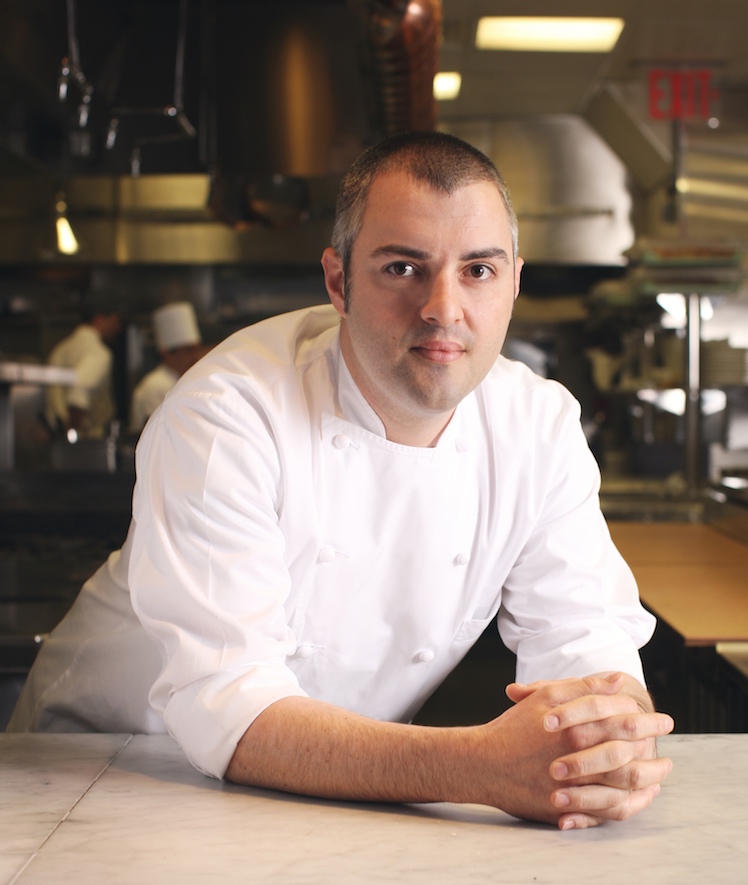
Mr.
Kreuther left The Modern a year ago (he’s opening
his own place soon), and
one of his former cooks, Abram Bissell (right), took
over the kitchen in 2014, after
service as chef de cuisine at The NoMad
restaurant; before that he had been at
Eleven Madison Park (which Danny Meyer used to
own); earlier, after moving from
his home state of Florida, Mr. Bissell worked at
Boston’s L’Éspalier and the
Sierra Del Mar Restaurant at Post Ranch Inn in Big
Sur.
The
transition at The Modern has been seamless. Not
only is Mr. Bissell's cuisine
every bit as good as Mr. Kreuther's, but he has
performed the uncanny triumph
of maintaining the style of The Modern since its
inception while bringing it
very much into a new era. Just about every
dish showed a refined taste
level for which The Modern is justly known and of
a kind that proves
indisputably that this kind of cuisine lives and
thrives.
Can
one find dishes like this in Brooklyn or in the
Lower East Side or Bowery
storefronts cooked up in cramped, noisy, barebones
kitchens with three cooks
behind the stoves? Occasionally, yes. But not
with The Modern’s degree of
consistency or elegance—-the kitchen brigade is
very large and the space itself
huge--so when I hear the drumbeats of our current
food media about how people
don't want to dine in places like The Modern
anymore, I would show them the sea
of customers that filled both rooms the night I
was there, as well as at Le
Bernardin, Daniel, Gotham Bar & Grill,
Gramercy Tavern and so many more. Photo:
Melissa Hom
Our
meal
began with a lovely foie gras and orange tart in a
sweet fennel
vinaigrette, the flavors subtle and wholly
pleasing as a starter. Fresh roasted
foie gras was superb, linked with bitter red
endive and sweet-tangy quince,
while a potato-thickened potage of scallops and
Scottish langoustine with leeks and frisée lettuce
might
be a signature dish at any three-star restaurant
in Paris charging thrice the
price. As an appetizer, a good portion of lobster
was marinated with truffles
(though they were barely evident), radishes and
herbs (below).
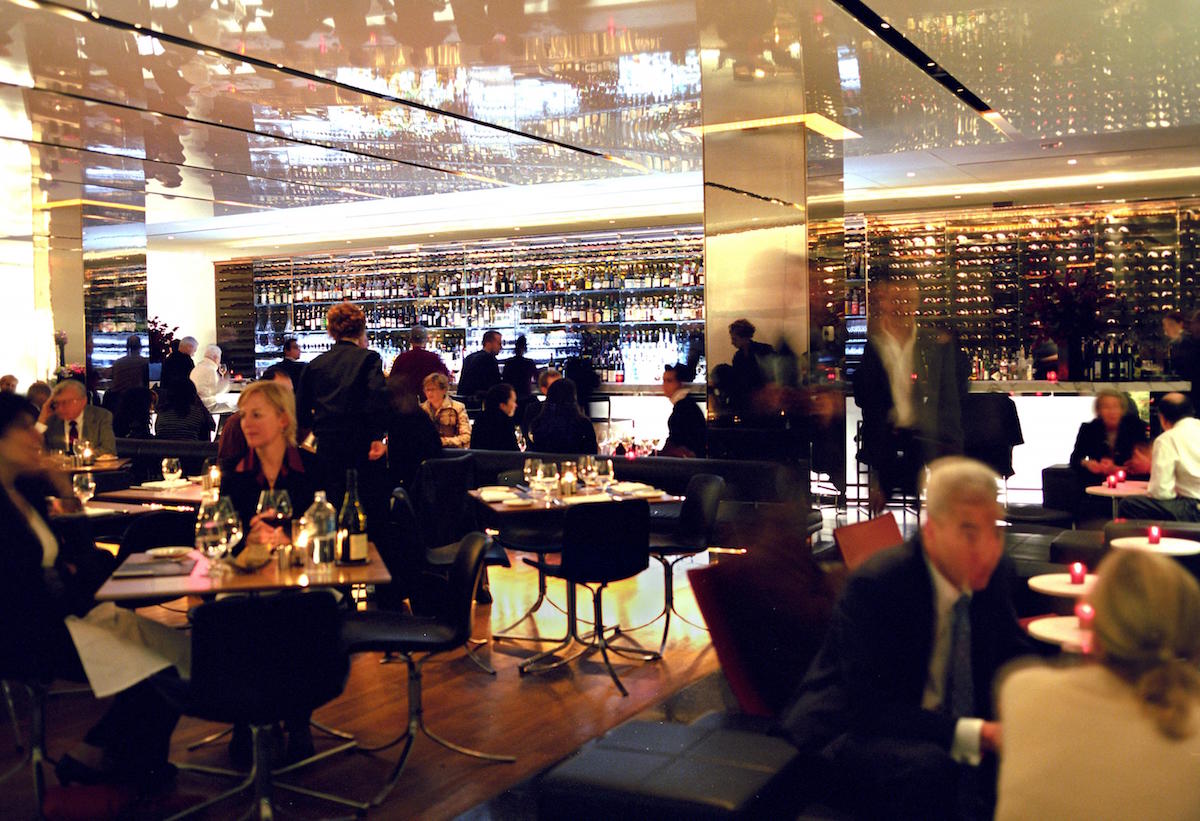 The
winemaker from Washington state with whom I was
dining insisted on ordering
salmon (I thought he’d prefer to try another
species in New York) and was
rewarded with a silky slice of nonpareil wild
Alaska salmon with a classic sorrel
sauce, creamy potatoes and lettuce. Mr. Bissell
learned well his lessons from
Mr. Kreuther about roasting suckling pig, for it
was perfect, its spices
enhancing the flesh and crisp skin, with dried
plums and onions sweetening the
dish to wonderful, succulent effect.
Another classic, duck en
chartreuse, with apples and green
peppercorns, showed the precision with
which this kitchen works in spicing, forming, and
slowly cooking a dish
suffused with flavor. According to Mr. Bissell,
"the duck breasts are
The
winemaker from Washington state with whom I was
dining insisted on ordering
salmon (I thought he’d prefer to try another
species in New York) and was
rewarded with a silky slice of nonpareil wild
Alaska salmon with a classic sorrel
sauce, creamy potatoes and lettuce. Mr. Bissell
learned well his lessons from
Mr. Kreuther about roasting suckling pig, for it
was perfect, its spices
enhancing the flesh and crisp skin, with dried
plums and onions sweetening the
dish to wonderful, succulent effect.
Another classic, duck en
chartreuse, with apples and green
peppercorns, showed the precision with
which this kitchen works in spicing, forming, and
slowly cooking a dish
suffused with flavor. According to Mr. Bissell,
"the duck breasts are
I suppose
a chicken dish is inevitable anywhere, but Mr.
Bissell has borrowed from a
similar, signature item at The NoMad, stuffing
pistachios and foie gras under the skin of a
beer-brined bird,
so that when it is sliced, you get this steamy,
swoon-worthy aroma and crisp
skin, along with acorn squash and chanterelles.
As
you walk into the dining room you may notice a
splendid cheese cart, but you’ll
have to ask for it because they don’t wheel it
through for each table to
see. If
you do order some
selections, you will be thoroughly informed of the
cart’s offerings, though, as
is the baffling case in American restaurants, the
cart is wheeled away and
the cheeses plated somewhere out of sight, rather
than, as in Europe, plated in
front of you, which saves time and increases the
gustatory anticipation. 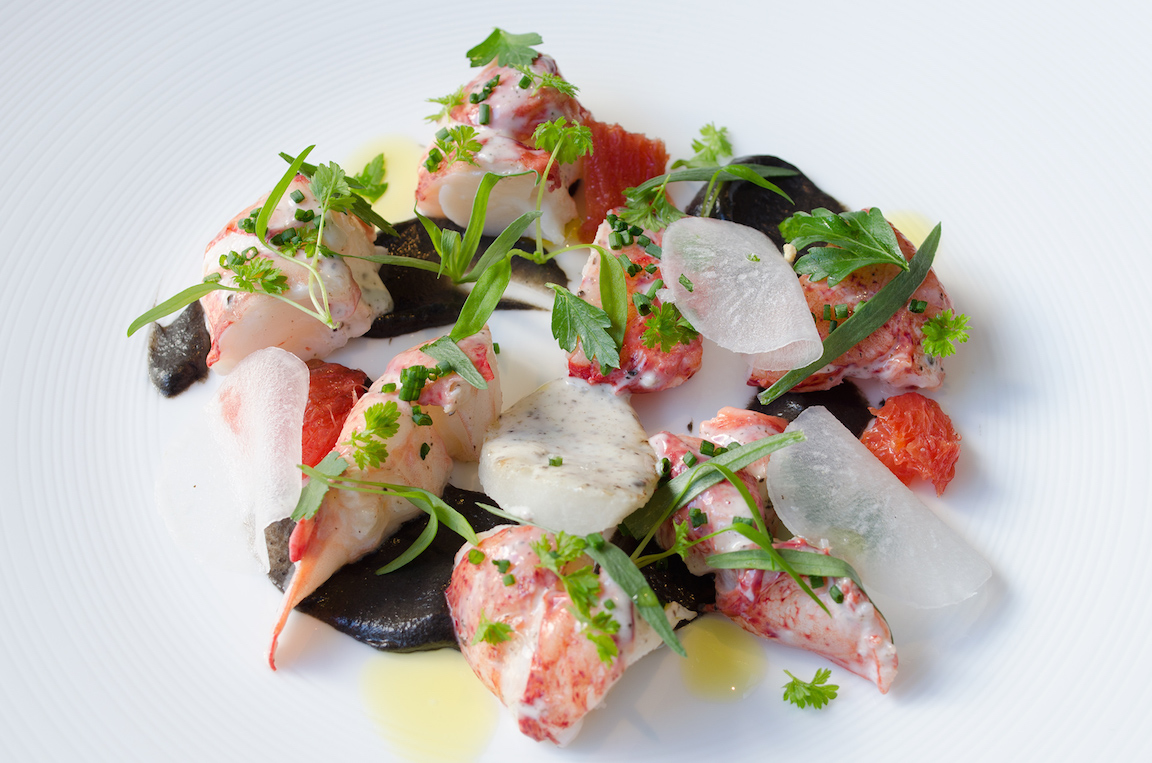
Pastry chef Jiho Kim, Korean-born, is
wholly in step with The Modern’s
commitment to elegant presentations, as evident in
his green apple panna cotta
on almond layer cake with lemon verbena ice cream,
and in his rich and sensuous
gianduja crèmeux
with wafer streusel
and Nutella ice cream.
The
Modern’s wine list has always been distinguished
among the finest in the world,
and Master Sommelier Michaël Engelmann has made
sure there is nothing on that
list that does not have good cause to be there.
The
fear
of becoming jaded after forty years of writing
about restaurants might
well occur, were I based in any other city but New
York. Even in Paris there is
little but French cuisine, however fine it may be.
In Hong Kong, too many
Chinese restaurants can dull the palate. In Rome,
a thousand wonderful pasta
dishes can make one long for something else. In
NYC, however, that is simply
not possible, and restaurants like The Modern,
refreshed and infused with
eager, young talents like Mr. Bissell and
maintained with a very specific and
very genteel NYC character by Mr. Meyer only mean
that I could never ever lose
my appetite for dining out in a city that has
always been the stewpot of
culinary culture.
The Modern is open at
the Bar for lunch and dinner daily, with the
main dining room open for lunch
Mon.-Fri. and dinner Mon.-Sat. Fixed price
dinner menu $98 for three courses,
$108 for four,
$128 for seven.
♥︎
COLUMBIA WINERY GOES PROGRESSIVE
AT A PRICE EASY TO LOVE
By John Mariani
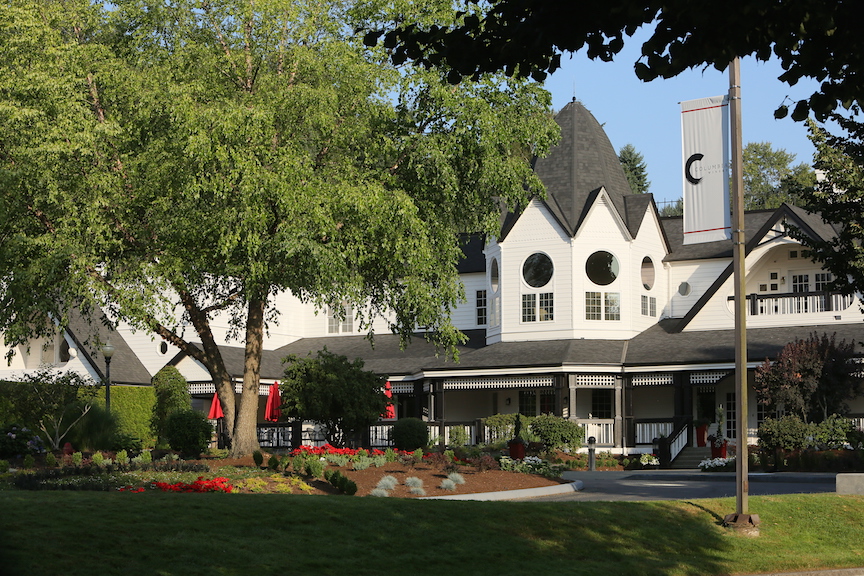 As every
wine writer and connoisseur knows,
wine tasting pronouncements offer a higher
degree of error than any critical
judgments except for modern art.
The chance of being fooled into overpraising a
wine tasted blind is part
of the game, just as is underpraising a wine
while staring at the label. Thus, many
inexpensive wines may
receive high points when the label is hidden as
they might receive low points
if the label were in view.
As every
wine writer and connoisseur knows,
wine tasting pronouncements offer a higher
degree of error than any critical
judgments except for modern art.
The chance of being fooled into overpraising a
wine tasted blind is part
of the game, just as is underpraising a wine
while staring at the label. Thus, many
inexpensive wines may
receive high points when the label is hidden as
they might receive low points
if the label were in view.
It’s human nature, of course, to fall in line with accepted opinion, that a First Growth Bordeaux or California cult wine will always win high marks while a $10 Argentine wine may get grudging respect. But increasingly it is in the price range of wines between $10 and $20 that educated opinion is shifting, because so many delicious examples are now in the market, many of them blends of grapes bought from others’ vineyards, not raised or owned by the vintner on the label. Of course, that is also the case in Burgundy, where an illustrious bottling may be a blend of several estates’ grapes, the same as with many of the most highly regarded California cabernets.
This was brought into clear focus for me while tasting several wines made by Columbia Winery in Washington State, established in 1962 and not long ago purchased by the E & J Gallo conglomerate, better known for its high volume, cheap 3-liter jug wines like Carlo Rossi and Boone’s Farm. Indeed, for decades Gallo pretty much ignored the question “Why can’t a company as big and rich as Gallo make fine premium wines?”
Only in
the 1990s did Gallo start to win over the wine
media with indisputable quality,
with their Turning Leaf brand, which sold for
about $7 a bottle. Purchasing the
historic Louis M. Martini and Mirassou wineries
gave them further prestige, and
their Gallo Family Vineyards line, with bottles priced above $10,
gave them more bragging rights. 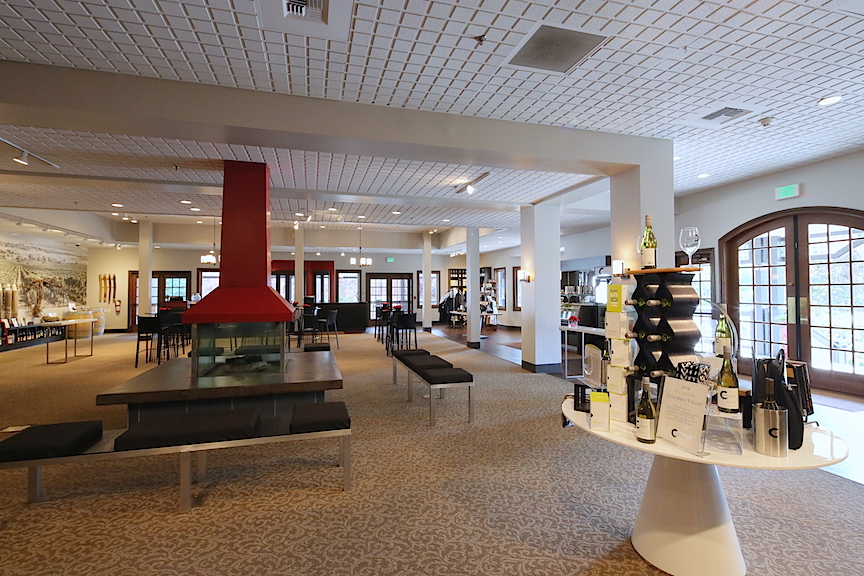
The purchase of Columbia Winery, which pioneered plantings of Syrah, Pinot Gris and Cabernet Franc grapes, gives Gallo a place in that sweet spot of $12-$20, where most wine lovers actually feel comfortable, with four wines now available nationwide, as well as in the winery's tasting room (right): Composition Red Blend, Chardonnay, Cabernet Sauvignon and Merlot, drawing on a wide variety of Washington’s 43,000 acres of vineyards, largely from Columbia Valley, Yakima Valley, Horse Heaven Hills, Wahluke Slope and Red Mountain.
Columbia
Winery’s winemaker, Sean Hails (below), a
Canadian with wide training and experience in
Australia and Canada, joined Gallo in 2005 and
came to oversee production at
Columbia Winery just three years ago.
“The
wide selection of grapes here provides me with an
artist’s palette to work with
in the cellar,” he says. “This diversity endures
throughout the entire
winemaking process as I’m always using new yeast
strains and oak regimes to
make the best possible blends that always pair
well with food.”
Clearly, Gallo wants Hails to produce wines at a certain value but made with high quality in mind, which is where Columbia’s current wines prove that bottle price is not always an indicator of quality. Over dinner with Hails at The Modern restaurant (see article above) in New York, I found the wines not just cleanly made and well structured but having an individuality among them that indicated his talent for blending for consistent flavor.
The 2013 Columbia Valley Chardonnay ($15) largely comes from grapes grown in Yakima Valley, where in 2013 the moderate, gradually rising temperatures aided steady maturation and acidity. Oak contact during fermentation is obvious in the West Coast style of Chardonnay, made with 92% Chardonnay, 5% Pinot Gris, and 3% other white, achieving a reasonable 13.6% alcohol level. I found it a little sweet underneath its fruit, good for sipping as an aperitif or with a shellfish.
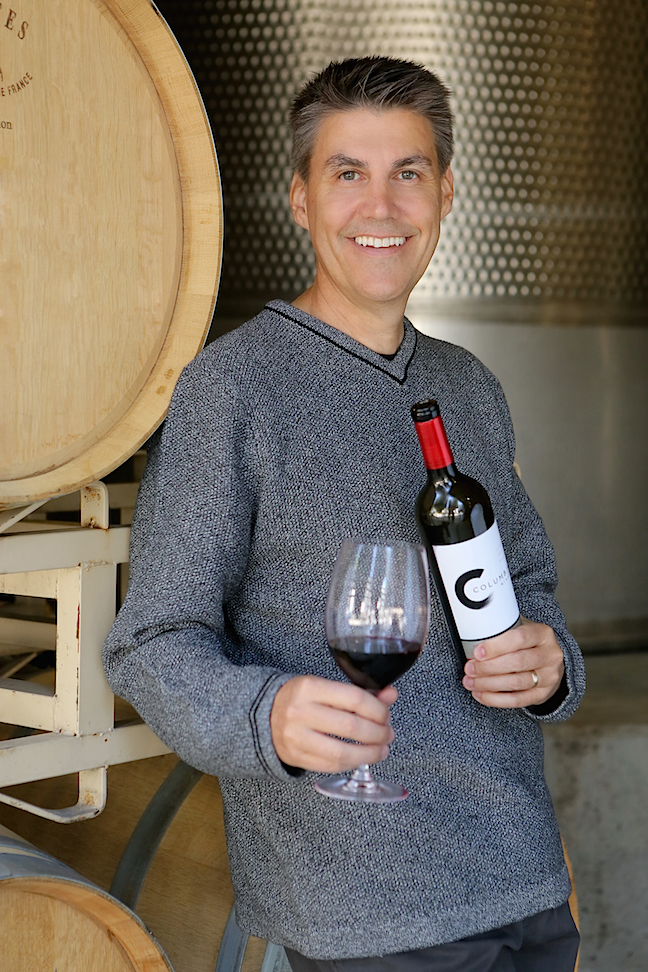 The
awkwardly named Composition Red Blend ($17)
is a wine Hails says exemplifies his
“progressive winemaking,” beginning with a
soft Merlot majority of 55% blended with 26%
spicy Syrah, 10% Malbec, 4%
Cabernet Sauvignon and 5% other red varietals,
with an alcohol of 13.7%. The bottle
shows no vintage because, says
Hails, “With multiple incredible vintages in a
row, it was hard to choose just
one, so we didn’t.” Instead, he selected his
favorite lots to create the best
wine out of grapes from the Yakima Valley, Horse
Heaven Hills, Wahluke Slope
and a small portion of Red Mountain.
Not only is the composition of grapes somewhat
out of the ordinary but
the reliance on different vintages—a practice
with a long history elsewhere but
little prestige among red wines—shows the wisdom
of the practice, just as in
the blending of fortified wines like Port or
Sherry. The nuances come from the
strengths of each vintage used, so Composition
Red Blend has plenty of
complexity.
The
awkwardly named Composition Red Blend ($17)
is a wine Hails says exemplifies his
“progressive winemaking,” beginning with a
soft Merlot majority of 55% blended with 26%
spicy Syrah, 10% Malbec, 4%
Cabernet Sauvignon and 5% other red varietals,
with an alcohol of 13.7%. The bottle
shows no vintage because, says
Hails, “With multiple incredible vintages in a
row, it was hard to choose just
one, so we didn’t.” Instead, he selected his
favorite lots to create the best
wine out of grapes from the Yakima Valley, Horse
Heaven Hills, Wahluke Slope
and a small portion of Red Mountain.
Not only is the composition of grapes somewhat
out of the ordinary but
the reliance on different vintages—a practice
with a long history elsewhere but
little prestige among red wines—shows the wisdom
of the practice, just as in
the blending of fortified wines like Port or
Sherry. The nuances come from the
strengths of each vintage used, so Composition
Red Blend has plenty of
complexity.
The 2013 Columbia Valley
Cabernet Sauvignon ($17) shows at a young
age all the ripeness, intense dark
fruit, acidity and remarkable balance
that you’d expect from older West Coast
Cabernets. The tannins have
already softened. Forty percent of the grapes
were sourced 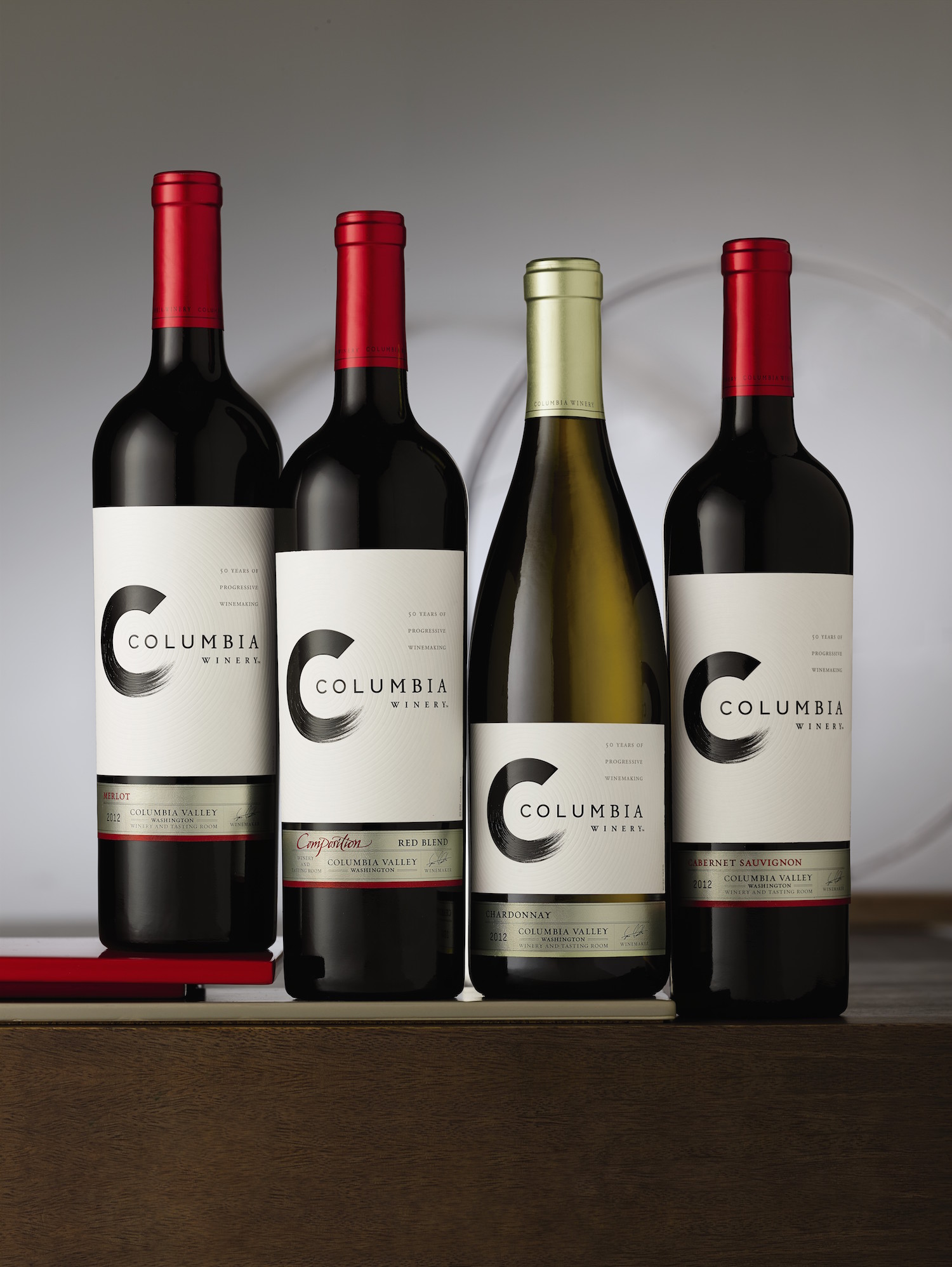 from premier
vineyards in Wahluke Slope and Horse Heaven
Hills, where a warmer, drier
climate produces grapes with approachable
tannins. Its components were 81% Cabernet,
13% Syrah, 3% Malbec, and 3% other red
varietals, with a very
commendable 13.5% alcohol that proves West Coast
Cabernets need not soar to 15%
and above to achieve ripeness and intensity.
from premier
vineyards in Wahluke Slope and Horse Heaven
Hills, where a warmer, drier
climate produces grapes with approachable
tannins. Its components were 81% Cabernet,
13% Syrah, 3% Malbec, and 3% other red
varietals, with a very
commendable 13.5% alcohol that proves West Coast
Cabernets need not soar to 15%
and above to achieve ripeness and intensity.
The 2013 Columbia Valley Merlot ($17) is an enchanting, soft red wine that is also very versatile; it will go with just about any red meat, poultry, or Pacific Northwest salmon, and will pair well with any sweeter flavors in a sauce, like duck à l’orange. Here the oak adds interest early on, with a fine 13.9% alcohol level.
Those alcohol levels say something about Hails'—and Gallo’s—intentions at Columbia Winery. They are not trying to mimic Bordeaux, instead showing off a robust California style of red wine without the brash over-ripeness and high alcohol of so many California examples. And to do that at the prices Columbia Winery charges means that having one of the world’s largest wineries at your back can achieve high quality in large volume.
♥︎

SEE, THE NEW,
MUCH CLASSIER LAS VEGAS
IS NOT JUST ALL
ABOUT
GAMBLING!
The first
White Castle in Las Vegas has opened at the Best Western
Plus Casino Royale, beneath the world's largest Denny's,
and people have been waiting up to three hours to get
in. It had to close after one day until it could be
re-stocked with food.
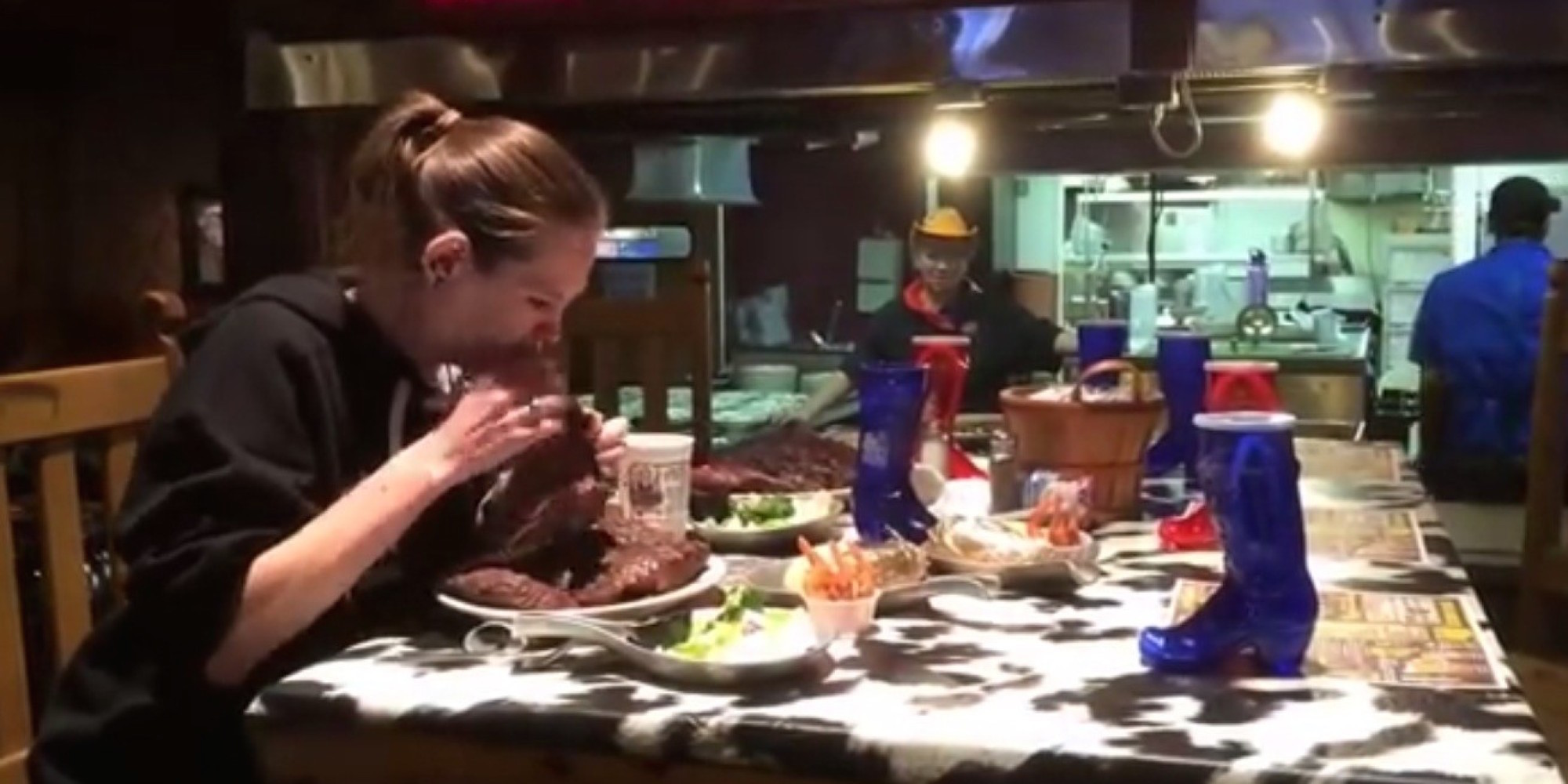
Molly
Schuyler of Bellevue, Nebraska, who is said to weigh 120
pounds, ate two 72
oz. steaks at the Amarillo’s Big Texas Steak Ranch
Steak House
in less
than 20 minutes. Molly posted the full video of her
eat-a-thon on YouTube
and said she plans to return for to try to consume three
entire meals in under an hour.
Any of John Mariani's books below may be ordered from amazon.com.
 I'm proud and happy to announce that my
new book, The Hound
in Heaven (21st Century Lion Books), has just
been published through Amazon and Kindle.
I'm proud and happy to announce that my
new book, The Hound
in Heaven (21st Century Lion Books), has just
been published through Amazon and Kindle. It is a novella, and for anyone who loves dogs, Christmas, romance, inspiration, even the supernatural, I hope you'll find this to be a treasured favorite. The story concerns how, after a New England teacher, his wife and their two daughters adopt a stray puppy found in their barn in northern Maine, their lives seem full of promise. But when tragedy strikes, their wonderful dog Lazarus and the spirit of Christmas are the only things that may bring back his master back from the edge of despair.
WATCH THE VIDEO!
“What a huge surprise turn this story took! I was completely stunned! I truly enjoyed this book and its message.” – Actress Ali MacGraw
“He had me at Page One. The amount of heart, human insight, soul searching, and deft literary strength that John Mariani pours into this airtight novella is vertigo-inducing. Perhaps ‘wow’ would be the best comment.” – James Dalessandro, author of Bohemian Heart and 1906.
“John Mariani’s Hound in Heaven starts with a well-painted portrayal of an American family, along with the requisite dog. A surprise event flips the action of the novel and captures us for a voyage leading to a hopeful and heart-warming message. A page turning, one sitting read, it’s the perfect antidote for the winter and promotion of holiday celebration.” – Ann Pearlman, author of The Christmas Cookie Club and A Gift for my Sister.
“John Mariani’s concise, achingly beautiful novella pulls a literary rabbit out of a hat – a mash-up of the cosmic and the intimate, the tragic and the heart-warming – a Christmas tale for all ages, and all faiths. Read it to your children, read it to yourself… but read it. Early and often. Highly recommended.” – Jay Bonansinga, New York Times bestselling author of Pinkerton’s War, The Sinking of The Eastland, and The Walking Dead: The Road To Woodbury.
“Amazing things happen when you open your heart to an animal. The Hound in Heaven delivers a powerful story of healing that is forged in the spiritual relationship between a man and his best friend. The book brings a message of hope that can enrich our images of family, love, and loss.” – Dr. Barbara Royal, author of The Royal Treatment.
 |
The Encyclopedia of American Food and Drink by John F. Mariani (Bloomsbury USA, $35) Modesty forbids me to praise my own new book, but let me proudly say that it is an extensive revision of the 4th edition that appeared more than a decade ago, before locavores, molecular cuisine, modernist cuisine, the Food Network and so much more, now included. Word origins have been completely updated, as have per capita consumption and production stats. Most important, for the first time since publication in the 1980s, the book includes more than 100 biographies of Americans who have changed the way we cook, eat and drink -- from Fannie Farmer and Julia Child to Robert Mondavi and Thomas Keller. "This book is amazing! It has entries for everything from `abalone' to `zwieback,' plus more than 500 recipes for classic American dishes and drinks."--Devra First, The Boston Globe. "Much needed in any kitchen library."--Bon Appetit. |
"Eating Italian will never be the same after reading John Mariani's entertaining and savory gastronomical history of the cuisine of Italy and how it won over appetites worldwide. . . . This book is such a tasteful narrative that it will literally make you hungry for Italian food and arouse your appetite for gastronomical history."--Don Oldenburg, USA Today. "Italian
restaurants--some good, some glitzy--far
outnumber their French rivals. Many of
these establishments are zestfully described
in How Italian Food Conquered the World, an
entertaining and fact-filled chronicle by
food-and-wine correspondent John F.
Mariani."--Aram Bakshian Jr., Wall Street
Journal.
"Equal parts
history, sociology, gastronomy, and just
plain fun, How Italian Food Conquered the
World tells the captivating and delicious
story of the (let's face it) everybody's
favorite cuisine with clarity, verve and
more than one surprise."--Colman Andrews,
editorial director of The Daily
Meal.com. "A fantastic and fascinating
read, covering everything from the influence
of Venice's spice trade to the impact of
Italian immigrants in America and the
evolution of alta cucina. This book will
serve as a terrific resource to anyone
interested in the real story of Italian
food."--Mary Ann Esposito, host of PBS-TV's
Ciao
Italia. "John Mariani has written the
definitive history of how Italians won their
way into our hearts, minds, and
stomachs. It's a story of pleasure over
pomp and taste over technique."--Danny Meyer,
owner of NYC restaurants Union Square
Cafe, The Modern, and Maialino.
|
 |
 |
 |
 |
 |
 |
 |
 |
 Everett Potter's Travel Report:
Everett Potter's Travel Report: 
 Eating Las Vegas
is the new on-line site for Virtual Gourmet
contributor John A. Curtas., who since 1995
has been commenting on the Las Vegas food
scene and reviewing restaurants for Nevada
Public Radio. He is also the
restaurant critic for KLAS TV, Channel 8 in
Las Vegas, and his past reviews can be
accessed at KNPR.org.
Click on the logo below to go directly to
his site.
Eating Las Vegas
is the new on-line site for Virtual Gourmet
contributor John A. Curtas., who since 1995
has been commenting on the Las Vegas food
scene and reviewing restaurants for Nevada
Public Radio. He is also the
restaurant critic for KLAS TV, Channel 8 in
Las Vegas, and his past reviews can be
accessed at KNPR.org.
Click on the logo below to go directly to
his site.

Tennis Resorts Online: A Critical Guide to the World's Best Tennis Resorts and Tennis Camps, published by ROGER COX, who has spent more than two decades writing about tennis travel, including a 17-year stretch for Tennis magazine. He has also written for Arthur Frommer's Budget Travel, New York Magazine, Travel & Leisure, Esquire, Money, USTA Magazine, Men's Journal, and The Robb Report. He has authored two books-The World's Best Tennis Vacations (Stephen Greene Press/Viking Penguin, 1990) and The Best Places to Stay in the Rockies (Houghton Mifflin, 1992 & 1994), and the Melbourne (Australia) chapter to the Wall Street Journal Business Guide to Cities of the Pacific Rim (Fodor's Travel Guides, 1991).


MARIANI'S VIRTUAL GOURMET
NEWSLETTER is published weekly. Editor/Publisher: John
Mariani.
Editor: Walter Bagley. Contributing Writers: Christopher Mariani,
Robert Mariani, Misha
Mariani,
John A. Curtas, Edward Brivio, Mort Hochstein,
Andrew Chalk, Dotty Griffith and Brian Freedman. Contributing
Photographers: Galina Dargery, Bobby
Pirillo. Technical Advisor: Gerry McLoughlin.
To un-subscribe from this newsletter,click here.
© copyright John Mariani 2015

